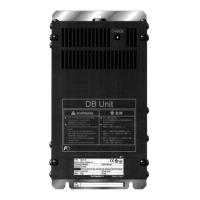11.9 Power Regenerative PWM Converters, RHC Series
11-35
SELECTING PERIPHERAL EQUIPMENT
Chap 11
[ 2 ] Common specifications
AVR constant control with DC ACR minor
Running/Stopping Starts rectification when the converter is powered ON after connection.
Starts boosting when it receives a run signal (terminals [RUN] and [CM] short-circuited or a
run command via the communications link).
After that, the converter is ready to run.
Running, power running, regenerative operation, ready-to-run, alarm output (for any alarm),
etc.
CT/VT switching Switching between CT and VT modes.
CT: 150% of overload rating for 1 min
VT: 120% of overload rating for 1 min
Fixed to high carrier frequency
Stops the gates (boosting) when the voltage level reaches the undervoltage level if a
momentary power failure occurs, and the converter can automatically restart after the power
Controls the power not to exceed the preset limit value.
AC fuse blown, AC overvoltage, AC undervoltage, AC overcurrent, AC input current error,
input phase loss, synchronous power supply frequency error, DC fuse blown, DC overvoltage,
DC undervoltage, charge circuit fault, heat sink overheat, external alarm, converter internal
overheat, overload, memory error, keypad communications error, CPU error, network device
error, operation procedure error, A/D converter error, optical network error, IPM error
Alarm history Saves and displays the most recent 10 alarms.
Saves and displays the detailed information of the trip cause for the previous alarm.
Displays input power, input current in RMS, input voltage in RMS, DC link bus voltage and
power supply frequency.
Allows the user to measure the load factor with the keypad.
Allows the user to check and modify function codes in any of the three languages--Japanese,
English or Chinese.
Lights when the DC link bus capacitor is charged.

